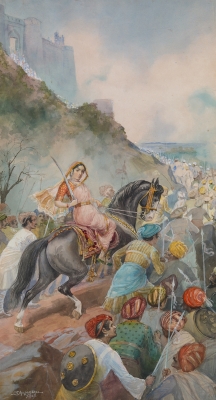
Shivaji’s sole surviving son Rajaram died in 1700, locked in fierce combat with the Mughals, Aurangzeb was overjoyed, he thought the Maratha menace was finally at an end. It was at that time that Rajaram’s twenty-five-year-old widow Tarabai came into her own. She declared her four-year-old son as king under the name Shivaji II, throwing aside the claim to the throne of her husband’s elder brother Sambhaji’s son Shahu, still in Mughal captivity, with the argument that a king in hand was worth any number in the bush. She bribed, cajoled and convinced the Maratha generals to support her.
As the Mughals historian Khafi Khan put it. ‘The chiefs then made Tara Bai, the chief wife [and] the mother of one son [of Rajaram], regent. She was a clever, intelligent woman, and had obtained a reputation during her husband’s lifetime for her knowledge of civil and military matters.’
Leads from front
In the seven-year period from 1700 to 1707, Tarabai single-handedly directed the Maratha defence against Aurangzeb’s army. She led the attacks from the front, travelling between forts, mobilising resources and motivating her commanders. She also mastered and motivating her commanders. She also mastered Aurangzeb’s technique of bribing commanders on both sides of the conflict. Bhinsen, a Mughal officer, stated in his Tarikh-i-Dilkusha that Tarabai ‘was a stronger ruler than her husband’. He also observed that Tarabai ‘became all in all and regulated things so well that not a single Maratha leader acted without her order’.
Tarabai’s ingenious move
Meanwhile, sick of the corruption among his officers, the increasingly senile 82-year old Aurangzeb decided to personally handle the campaign – he dragged himself from fort to fort from 1701 to 1706 taking them over over one by one.
To counter Aurangzeb, Tarabai made an ingenious move based on the old military maxim that the best defence is offence. Every year, she sent large forces of up to 50,000 troops beyond the Marathi-speaking Deccan deep into Mughal domains in the north, as far as Malwa and Gujarat, even as her major Maratha forts were falling into Aurangzeb’s hands. Her troops set up a sort of parallel government to the Mughals in these areas. Tarabai’s clear vision and unerring judgement was visible both on the battlefield as well as in the council chamber. Sick an dispirited, Aurangzeb finally died in 1707 at the age of eighty-nine and was buried in Aurangabd.
Becomes Quasi-Sovereign Dowager
Aurangzeb’s successor Bahadur Shah I released Shahu, Sambhaji’s son. However, Tarabai would not give up her power, and after many battles, two Maratha kingdoms were created, one centred in Kolhapur and one at Satara. However, the power finally shifted to Shahu and his Peshwa Balaji Vishwanath Tarabai eventually came to an understanding with the Peshwa, and for the rest of her days, she rule as a quasi-sovereign dowager, issuing edicts, building temples etc. She died at the age of 86 in 1761, some months after seeing the Maratha debacle at Panipat.
Had Tarabai not been there in 1701, it is quite likely that Aurangzeb would have snuffed out Maratha rule completely, and the history of India would have been quite different.
The historian Jadunath Sarkar commented, ‘In that awful crisis her character and strength saved the nation.’
Picture Credit : Google

